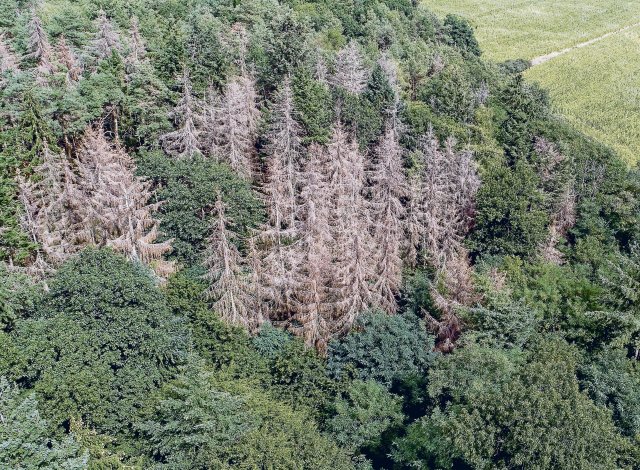Climate change-related heat and drought stress is already causing spruce trees to die in many places.
Foto: picture alliance/dpa/Patrick Pleul
Long-lasting hot dry phases, more frequent forest fires, more intense autumn storms and pests such as bark beetles are among the causes of extensive, large-scale tree death. Depending on the region, a third to half of the tree species growing in Europe could no longer be able to cope with future climate conditions. This is the result of a study published in April in the specialist journal »Nature Ecology & Evolution« has been published.
In order to compensate for the losses, tree species that tolerate both current and future climate conditions would have to be planted. Species-rich mixed forests are particularly resilient to disturbances. But which tree species are suitable for this?
Scientists from the University of Vienna and the Technical University of Munich investigated this question. They examined the current distribution of 69 of the most common tree species, using data from almost 240,000 locations across Europe. They then modeled whether the regional locations of these trees would continue to be suitable for reforestation of forest areas under certain emissions scenarios until the end of the century according to defined criteria.
Result: The average number of tree species per square kilometer could decrease between 33 and 49 percent, depending on the scenario. This means that a smaller number of European tree species are available for reforestation over the entire 21st century. Tree species to be planted should be suitable for reforestation not only under current but also under future climate conditions. They would have to withstand cold and frost as well as a hotter and drier climate at the end of the 21st century.
nd.DieWoche – our weekly newsletter

With our weekly newsletter nd.DieWoche look at the most important topics of the week and read them Highlights our Saturday edition on Friday. Get your free subscription here.
Big regional differences
The diversity of suitable tree species in Europe already differs greatly – for example between Germany, Finland and Spain. In one region, the extinction of just a few common species in a habitat with low biodiversity could lead to a critical reduction in the total number of suitable species, while in other regions a larger selection may remain.
The researchers conclude that options for forest conversion will be more limited by climate change. Large-scale losses of tree species will severely limit the creation of mixed forests in some regions of Europe. In order for forest ecosystems to remain intact and continue to provide important ecosystem services – such as storing carbon or providing food and habitat for animals – climate change must be contained, the authors emphasize.
Among the commercial tree species in Central Europe – spruce, pine, beech, oak, Douglas fir – spruce in particular will lose vitality and show increased mortality, and in the drier lowland regions regionally also beech and pine, fears Christoph Leuschner from the Georg-August University of Göttingen . And this is also likely to apply to Douglas fir in drier, low-lying areas. The oaks are likely to be the most likely to cope with the warming, although pest and disease infestations will also increase here.
Mixed forests with five to eight species
The plant ecologist criticizes that mixed forests of the future almost always mean only two species – such as Douglas fir with a deciduous tree such as beech. Species-rich mixed forests with five to eight species are hardly planned anywhere. Deciduous tree species such as Norway maple, hornbeam, winter lime and serviceberry are missing from today’s silvicultural planning. Although conifers are more profitable, almost all are quite sensitive to drought and heat stress, so they are likely to fail sooner than the more tolerant deciduous tree species.
The number of tree species in question generally decreases in the warmer lowlands compared to the cooler mountainous areas. If the climate continues to warm so drastically, only a few tree species that are planted today are likely to survive the usual rotation period of 60 to 100 years from planting to timber harvest in the lowlands. Damage that can be seen today in ash, black alder or even sycamore maple can then also affect other species.
The study’s predictions on the distribution of tree species are completely inadequate, criticizes Pierre Ibisch, professor of nature conservation at the Eberswalde University for Sustainable Development. The average values and the increase in temperature and precipitation fluctuations taken into account in the study were not sufficient to predict the effects of combined weather events as well as critical extremes.
For example, the disappearance of Arctic ice and weakened Atlantic ocean currents could cause more violent weather rollercoasters in the future.
Important role of local ecosystems
In addition, it is not taken into account that the viability and adaptability of trees locally and regionally depends significantly on soils, microclimate, land use and forestry. Harmful organisms such as insects or fungi or other microorganisms are also not taken into account enough. In addition, local influences on ecosystems are not sufficiently represented.
According to Ibisch, the study underestimates the interactions in the ecosystem, the consequences of which we have already experienced. Fire, disease, pests or human reactions to forest damage would severely impact ecosystems. The biologist believes that the search for supposedly adapted “miracle trees” is misleading. But he is convinced that, regardless of the tree species we choose to plant, we can support forest health through a variety of other measures.
#ndstays – Get active and order a promotional package
Regardless of whether it is pubs, cafés, festivals or other meeting places – we want to become more visible and reach everyone who values independent journalism with an attitude. We have put together a campaign package with stickers, flyers, posters and buttons that you can use to get active and support your newspaper.
To the promotional package
